Plant Information Resource Center
A Service Provided by Bohn's Farm and Greenhouses
Calamagrostis acutiflora 'Avalanche'Grass, Feather Reed
[
More Info
]
|

|
Calamagrostis acutiflora 'Eldorado'Grass, Feather Reed
Narrow green leaves variegated with a bright gold midrib. Similar to 'Karl Foerster' with its distinct upright clumping habit and attractive feathery plumes from early summer through fall. PPAF
[
More Info
]
|

|
Calamagrostis acutiflora 'Lightning Strike'Variegated foliage; white centers and green edges on 3 foot plants.
[
More Info
]
|

|
Calamagrostis arundinacea 'Karl Foerster'Grass, Feather Reed
[
More Info
]
|

|
Calamagrostis arundinacea 'Overdam'Grass, Feather Reed
[
More Info
]
|

|
Calamagrostis brachytrichaGrass, Korean Feather Reed
Clump-forming, warm season grass with bright green leaves reaching about 2 feet. In late summer blooms emerge with a pink tint and reach 3 to 4 feet. The feathery flowers fade to cream in fall and finish in a straw color in winter. A graceful addition to the shade or part shade garden! Will also tolerate sun with sufficient moisture. One of the few flowering grasses that is happy in the shade. Wonderful for cut flowers.
[
More Info
]
|

|
Calamintha nepeta 'Blue Cloud'Calamint
A trouble-free plant whose leaves smell strongly of mint. The small, glaucous green leaves resemble those of Nepeta. Beginning in early summer, tiny, tubular, pale lavender-blue flowers are produced in profusion on upright spikes just above the foliage. Their sweet nectar attracts butterflies, hummingbirds, and bees. This plant makes a great filler in the border garden and can also be used as an edging.
[
More Info
]
|

|
Calamintha nepeta 'Montrose White'Calamint
Plumes of delicate white flowers float over shiny mint-scented foliage June through October. Dense, mat forming foliage makes good edging plant. Excellent habit; stays upright without flopping. Heat and drought tolerant.
[
More Info
]
|

|
Calamintha nepeta ssp. nepetaCalamint
Plumes of delicate light blue flowers float over shiny mint-scented foliage from early summer to fall. Use in rock gardens, herb gardens and perennial borders. Grow in full sun with good drainage.
[
More Info
]
|

|
Callicarpa americanaBeautyberry, American
[
More Info
]
|

|
Callirhoe bushiiPoppy Mallow, Bush'S
Cup shaped magenta flowers bloom June through August. Rambling flower stems are more erect than those of the similar C. inbolucrata. Long tap root provides good drought tolerance buts makes transplanting of established plants more difficult.
[
More Info
]
|

|
Callirhoe involucrataPoppy Mallow, Purple
Showy, cup-shaped magenta flowers bloom June through frost. Foliage forms trailing stems that forms excellent ground cover or hangs over walls. Drought tolerant.
[
More Info
]
|

|
Campanula poscharskyana 'Blue Waterfall'Bellflower, Serbian
Vibrant violet-blue, star-shaped flowers cover plant in May and June. Prostrate sprawling foliage forms a low mounding ground cover. Tolerant of Midwest heat and humidity. May repeat bloom.
[
More Info
]
|

|
Campsis radicansTrumpet Vine
Woody vine with root-like holdfasts that attaches to any surface. Hummingbirds feed on nectar produced by clusters of orange-red trumpet-shaped flowers from July-September. Brown seed pods, up to 6" long form in late summer. Leaves are lustrous dark green.
[
More Info
]
|

|
Carex albicansSedge, Whitetinge
[
More Info
]
|

|
Carex amphibolaSedge, Creek
Compact, clump forming sedge with shiny, semi-evergreen foliage. Vigorous grower. Widely adaptable, preferring dry to moderate moisture conditions. A Midwest native.
[
More Info
]
|

|
Carex annectensSedge, Yellow Fruited
Missouri Native sedge with attractive yellow flower spikelet's and compact tufts of fine foliage. Flowers form in May, seeds in June. aka C. brachyglossa
[
More Info
]
|
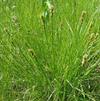
|
Carex bicknelliiSedge, Bicknell'S
Carex bicknellii can be found in North America from Eastern half of Canada and south to Kansas. It grows in dry and moist prairies, open woodlands and rocky areas. This Carex tolerates dry locations better than many sedges. It is useful for rain gardens, meadows, and areas where drought-tolerant plants are required. Bicknell’s Sedge grows in tufts of green, narrow, grasslike foliage and spreads by rhizomes. Copper-colored, oval-shaped seedheads appear in late spring giving it one of its common names. Carex bicknellii is named in honor of Eugene Pintard Bicknell (1859-1925), who is known for his keen observations of plant and animal life.
[
More Info
]
|
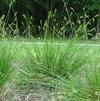
|
Carex breviorSedge, Shortbeak
A common sedge able to grow almost anywhere, most often found in the wild in dry, disturbed areas. Also called Plains Oval Sedge, Shortbeak Sedge actively grows during the spring and fall when soil temperatures are cool like most sedges (cool-season growers). In summer triangular leafy stems rise above low tufts of narrow grass-like foliage. The culms bear prickly green oval spikelets that transition into golden brown seed clusters.Leaf blades are usually about 1’ long and 1/8” wide. The leaf sheaths at the base of each blade has an unusual whitish color and an almost glassy appearance.
In late spring multiple leafy culms rise above the foliage to 3-4’. Each culm bears 2-6 oval flower spikes. Each green spikes contain upper pistillate and lower staminate florets. The spikelets are tapered at the base and bluntly pointed at the tip. The flowers transition into reddish brown summer seed spikes.
Plants are 1-4’ tall with an equal spread.
[
More Info
]
|

|
Carex eburneaSedge, Bristle-Leaved
Soft, thread-like, green foliage forms a spherical clump. Insignificant whitish-green flowers in April. Occurs naturally in limestone outcrops but also tolerates acid conditions.
[
More Info
]
|
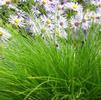
|
Carex elata 'Bowles Golden'Sedge, Golden
Bright gold foliage changing to light green later in the season. Requires consistent moisture to thrive. Provides bright accent in the shade garden.
[
More Info
]
|

|
Carex flaccospermaSedge, Blue Wood
Evergreen sedge forms attractive clumps of narrow, blue-green leaves. Thrives in moist conditions but will tolerate drought. An American native groundcover for shade. Greenish-white flower is insignificant.
[
More Info
]
|

|
Carex frankiiSedge, Frank'S
Hardy grass-like plant with green foliage. Bristle-like, brown seed heads in May to September. Native to floodplain woodlands. AKA Bristly Cattail Sedge.
[
More Info
]
|

|
Carex glauca 'Blue Zinger'Sedge, Blue
Steel blue semi-evergreen grass-like foliage. Colonizes to form a graceful ground cover. Thrives in moist soil but tolerates some drought. Provides winter interest.
[
More Info
]
|

|
Carex grayiSedge, Bur
Attractive, evergreen pleated foliage is lime green in full sun and dark green in part shade. Spiked flowers in May form star-like seed heads. A Midwest native.
[
More Info
]
|

|
Carex hachijoensis 'Evergold'Sedge, Variegated
Bright, creamy yellow leaves with green margins form dense graceful clumps. Semi-evergreen foliage provides winter interest. Prefers moist, rich soil but will tolerate some drought.
[
More Info
]
|

|
Carex hystericinaSedge, Bottlebrush
These are wetland sedges with prickly spikelets. The narrow leaves are light or medium green and arranged in loose or open tufts. In late spring triangular culms rise above the foliage to 3’ bearing the green bottlebrush shaped spikelets and the resulting brown seed spikes. This cool season sedge flourishes in sun or part sun but goes dormant during hot weather. Plants favor wet or consistently moist soils and tolerate seasonal flooding. Foliage is 2' tall with flower 3'.
[
More Info
]
|

|
Carex laxiculmus 'BUNNY BLUE Hobb'Sedge, Bunny Blue
Evergreen sedge has silvery blue foliage forming dense rounded clumps. Insignificant flower spikes appear in late spring. A strong growing clump former and good naturalizer.
[
More Info
]
|

|
Carex morrowii 'Ice Dance'Sedge, Variegated Japanese
Clear white margins on dark green leaves form compact, dense, colonizing tufts. Establishes quickly. Outstanding glasslike plant for the shade garden! Provides year round interest. An excellent, very winter hardy alternative to variegated Liriope.
[
More Info
]
|

|
Carex muskingumensisSedge, Palm
A dense, clump-forming sedge which is grown for its foliage effect. Produces rigid, erect stems to 20" tall with 8" long, pointed, grass-like, light green leaves radiating from the stem tops. Commonly called palm sedge since the leaves somewhat superficially resemble miniature palm fronds. A Missouri native which is found most often in wooded swamps and on wooded flood plains of rivers. Spread by rhizomes and self-seeding. Insignificant flowers appear in May on terminal spikes which are not showy but are noticeable and of some interest and persist throughout the summer. Foliage promptly turns yellow after frost. Species is named for the Muskingum River in Ohio.
[
More Info
]
|

|
Carex muskingumensis 'Little Midge'Sedge, Palm
Finley textured bright green leaves forms dense clumps. Dwarf selection maintains a neat and very uniform growth habit. Prefers consistently moist and fertile soil. Spreads by rhizomes.
[
More Info
]
|

|
Carex oshimensis 'Everest'Sedge, Variegated
White edged sport of Evergold. Striped evergreen foliage with distinctive silvery white edges that forms attractive 12- to 18-inch mounds. Once established, it offers good tolerance to dry conditions. Great for containers.
[
More Info
]
|

|
Carex pensylvanicaSedge, Pennsylvania
A compact sedge with arching, semi-evergreen, fine-texture foliage. An excellent shade to part shade groundcover. Tolerant of tough urban conditions, especially under trees. An American native.
[
More Info
]
|

|
Carex praegracilisSedge, Tollway
[
More Info
]
|

|
Carex radiataSedge, Straight-Styled Wood
Fine textured, grass-like, medium green foliage forms a tidy clump. A drought tolerant groundcover for shady sites. A Midwest native.
[
More Info
]
|

|
Carex strictaSedge, Tussock
A wetland native that grows in 2-3' tall clumps about 2' wide. As old leaves die, they build up around the living plant, making a "tussock" or little hill. It grows in or near water and spreads by rhizomes.
[
More Info
]
|

|
Carex vulpinoideaSedge, Fox
Missouri native sedge grows on moist open ground in swamps, wet prairies or near water, is one of the most abundant sedges in the state. Foliage consist of narrow grass-like leaf blades. The seed heads, which spray out attractively from the center of the clump, resemble a fox's tail but are short-lived.
[
More Info
]
|

|
Ceanothus americanusNew Jersy Tea Shrub
[
More Info
]
|

|
Centaurea montana 'Blue'Bachelor'S Button, Perennial
Cornflower-blue, fringed blooms that attract butterflies like magnets. Blooms in June and July.
[
More Info
]
|

|
Centranthus ruber 'Coccineus'Valerian
A profusion of cherry red flowers on top of glaucous foliage with a spreading habit. Cut back after the first bloom to encourage repeat bloom. Prefers well-drained, infertile, alkaline soil.
[
More Info
]
|

|
Cephalanthus occidentalisButtonbush
Blooms late June or July.
[
More Info
]
|

|
Ceratostigma plumbaginoidesLeadwort (Pumbago)
Long blooming gentian blue flowers from late June or July through frost. Glossy green leaves turn reddish bronze in autumn. Excellent, long-lived groundcover tolerates a wide range of conditions. Not evergreen. An excellent ground cover.
[
More Info
]
|

|
Chasmanthium (syn Uniola) latifoliumGrass, Northern River Oats
Upright clumps of bamboo-like foliage. Green foliage turns copper in fall and brown in winter. Attractive flat flower spikes hang down from flowering stems. Prefers light shade and damp locations. Can self-sow.
[
More Info
]
|

|
Chelone glabraTurtlehead
White spike flowers with a tinge of pink appear August through October. Flowers look like a turtle's head. Deep green foliage on upright stems looks good all season. A Midwest native.
[
More Info
]
|

|
Chelone glabra 'Black Ace'Turtlehead
Hooded, white, snapdragon-like flowers bloom August to October. Flowers resemble the head of an open mouthed turtle. Dark green foliage. Usually grows 3-4' but may grow to 6' in optimal conditions.
[
More Info
]
|

|
Chelone lyonii 'Hot Lips'Turtlehead
Dense spikes of rose red flowers for four weeks in late summer. Foliage is deeper green than the species. Stems are red and new spring growth has a bronze tint.
[
More Info
]
|

|
Chelone obliquaTurtlehead
[
More Info
]
|

|
Chelone obliqua 'Tiny Tortuga'Turtlehead
A tiny turtlehead with all the flower power of its taller brothers, this native cultivar features uniquely shaped, hot pink blooms atop lustrous dark green leaves with a bronzy sheen. Flowers reminiscent of turtles' mouths persist from mid-summer into fall, a favorite of butterflies but distasteful to deer. Its very compact habit is a great choice for mixed containers, or let it spread ever so slowly in the landscape along pond and stream edges, rain gardens or perennial borders.
[
More Info
]
|

|
Clematis 'Asao'Clematis
Huge rose pink flowers with white central bars and yellow stamens are highly fragrant. Largest flowers are 6-8" in May and June. Smaller flowers may appear in August and Sept. Attractive seed heads follow flowers and make excellent cut flowers.
[
More Info
]
|

|
Clematis 'Bee's Jubilee'Clematis
[
More Info
]
|

|
Clematis 'Belle of Woking'Clematis
Large silvery-mauve to white double flowers fade to silvery blue. Double flowers are 4-6" wide on old growth in May and June. Single flowers may appear on new growth in September and October.
[
More Info
]
|

|
Clematis 'Candida'Clematis
Huge pure white flowers with yellow stamens. Blooms are 6-9" June through July with slightly smaller flowers August and September. Long blooming variety.
[
More Info
]
|
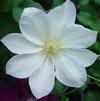
|
Clematis 'Dr. Ruppel'Clematis
Huge pale orchid, wavy petals with a wide carmine central bar and yellow stamens. Largest flowers are 6-8"on old growth in May and June. Smaller flowers may appear on new growth in August and September.
[
More Info
]
|

|
Clematis 'Duchess of Edinburgh'Clematis
Large fully double white rosette flower may be touched with green. Double flowers are 4-6" on old growth in May and June. Single flowers may appear on new growth in August and September
[
More Info
]
|

|
Clematis 'Fireworks'Clematis
Huge bicolor flowers are bright purple with a wide reddish-pink bar and contrasting purple tipped stamens. Largest flowers are 6-8" on old growth May and June. Smaller flowers in August and September.
[
More Info
]
|

|
Clematis 'H. F. Young'Clematis
A compact, free-flowering selection producing large blue flowers with pale yellow anthers. Produces attractive seed heads.
[
More Info
]
|

|
Clematis 'Henryi'Clematis
Huge pure white flowers have purple anthers. Blooms are 6-8" May and June with slightly smaller flowers July thru September. Vigorous Grower. Long blooming variety.
[
More Info
]
|

|
Clematis 'Miss Bateman'Clematis
Large creamy-white flowers have chocolate-red stamens. Blooms are 4-6" May and June with slightly smaller flowers July to September. Heirloom variety. Free flowering. Long blooming. One of the first large flowering varieties to bloom.
[
More Info
]
|

|
Clematis 'Montana Rubens'Clematis
Wonderful summer color from sweetly fragrant, soft pink, anemone-like flowers. This is one of the largest Clematis vines, often used for covering fences or sheds. Up to 20 ft. An intriguing ground cover or charming rambler, when allowed to sprawl or climb through informal shrub borders. New growth has purplish coloring, maturing to bronze-green. Deciduous.
[
More Info
]
|

|
Clematis 'Multi Blue'Clematis
Large deep purplish-blue flowers have a light silvery blue central bar. Double flowers are 4-6" on old growth in May and June. Single flowers appear August through October. Performs best in light shade.
[
More Info
]
|

|
Clematis 'Nelly Moser'Clematis
Pastel pink flowers with red bar. Blooms in May, June and September on new and old wood.
[
More Info
]
|

|
Clematis 'Picardy'Clematis
Very free flowering red/purple clematis. Clematis Picardy is particularly suitable for container growing.Enjoy the deep reddish purple blooms of Evipo024 Clematis Picardy™ throughout the summer. The 4" red/purple blooms surround the light brown center and take on an almost two tone look as the flowers age. Picardy™ Clematis is the perfect specimen for container gardening, standing only 4 foot tall it is just the right height for a patio or small garden. This free flowering Clematis vine should give you color throughout the summer months. Picardy™ is noted by many gardeners as one of their favorite container options. Clematis add vertical interest to gardens, landscapes and patio gardens.
[
More Info
]
|

|
Clematis 'Pink Champagne'Clematis
[
More Info
]
|

|
Clematis 'Rooguchi'Clematis
Cobalt-blue 2" bells. Free flowering May through September. Prune Group 3.
[
More Info
]
|

|
Clematis 'Rouge Cardinal'Clematis
Large crimson-red flowers have contrasting yellow anthers and rounded petals. Blooms are 4-6" June through July with slightly smaller blooms August and September. Long blooming variety. Also known as Red Cardinal.
[
More Info
]
|

|
Clematis 'Ruutel'Clematis
Huge magenta-red to pink flowers have black anthers. Blooms are 6-8" May through June with slightly smaller flowers July to October. Vigorous grower. Heavy bloomer. Compact size is good for containers.
[
More Info
]
|

|
Clematis 'The President'Clematis
Huge, rich purple-blue flowers have dark reddish-purple anthers. Blooms are 6-8" in May and June with slightly smaller flowers July to September. Attractive seed head. Vigorous. Long blooming. Easy to grow.
[
More Info
]
|

|
Clematis terniflora (syn paniculata)Clematis, Sweet Autumn
Masses of small pure white, highly fragrant blooms smother plant in late August and September. Vigorous twining vine grows rapidly. Will sprawl to form dense groundcover. Tolerates shade. Attractive fluffy seed head follows flower. May aggressively self-seed. Also know as C. paniculata.
[
More Info
]
|

|
Clematis texensis 'Princess Diana'Clematis
Tulip shaped,3",dark pink flowers have light pink margins and bright yellow anthers. Flowering starts in June and continues into September. Attractive seed heads. May be late to emerge. Tolerates heat and humidity. Cross between C. texensis and C.Bees Jubilee
[
More Info
]
|

|
Conoclinium coelestinumMist Flower (Wild Ageratum)
Blooms September through October. (FKA Eupatorium coelestinum)
[
More Info
]
|

|
Convallaria majalisLily Of The Valley
Tulip-like leaves coddle fragrant, white, bell-shaped flowers bloom late April and early May followed by tiny orange berries. Excellent ground cover for shade.
[
More Info
]
|

|
Coreopsis 'Daybreak'Coreopsis (Tickseed)
A shower of cheerful bicolor blossoms with a prominent orange-red center and fringed, gold petal tips appear over an extremely long period, from early summer through early fall in the Midwest. Since the flowers are sterile, they just keep on coming all season long without the need for deadheading.
It forms a compact, basal mound of highly disease resistant, dark green foliage. A midseason shearing will keep this plant looking its best all season.
If you’ve been pleased with the performance of Big Bang™ Coreopsis like ‘Mercury Rising’, you might also like to try the Li'l Bang™ series from the same breeder, master hybridizer Darrell Probst. These naturally compact cultivars exhibit the same great disease resistance and long bloom time (commencing a bit earlier than the Big Bangs) but measure in at about half the height. They are the perfect size for container gardening, rock gardens, and the front of the border.
[
More Info
]
|

|
Coreopsis 'Gold & Bronze UPTICK'Tickseed
Golden yellow flowers with dark red centers adorn the small, neat mound of the UPTICK Coreopsis series known for large, long-lasting blooms.
[
More Info
]
|

|
Coreopsis 'Jethro Tull'Coreopsis (Tickseed)
Golden yellow flowers with consistently fluted petals are produced atop a compact mound of foliage. Very floriferous! PPAF
[
More Info
]
|

|
Coreopsis 'UPTICK Cream & Red'Tickseed
Cream flowers with dark red centers adorn the small, neat mound of the UPTICK Coreopsis series known for large, long-lasting blooms.
[
More Info
]
|

|
Coreopsis 'Yellow & Red UPTICK'Tickseed
Golden yellow flowers with dark red centers adorn the small, neat mound of the UPTICK Coreopsis series known for large, long-lasting blooms.
[
More Info
]
|

|
Coreopsis grandiflora 'Early Sunrise'Coreopsis (Tickseed)
A profusion of brilliant golden-yellow, semi double, flowers flushed orange-yellow at the center May through August. A 1989 All-America Selection winner.
[
More Info
]
|

|
Coreopsis grandiflora 'Presto'Coreopsis (Tickseed)
Dwarf, mounding habit with large golden-yellow, semi-double to double flowers May through August.
[
More Info
]
|

|
Coreopsis Grandiflora 'Sunkiss'Coreopsis, Tickseed
Coreopsis 'Sunkiss' has the brightest yellow flowers and largest central blotching of any grandiflora type and they are produced in abundance on compact well-branching plants, from late spring right through to the hard frosts of autumn. What's more, this hardy perennial will bloom in your garden in the first year; unlike older coreopsis types - there's no waiting for 'Sunkiss' to perform. Inbuilt heat tolerance makes this the perfect addition to sunny hot spots in the garden, where other plants might frazzle in the heat of the summer sun.
[
More Info
]
|

|
Coreopsis lanceolataCoreopsis, Lance-Leaf
Showy, single, gold-yellow flowers on tall stems in May and June.
[
More Info
]
|

|
Coreopsis palmataCoreopsis, Prairie
Pale yellow flowers--much softer in color than those of our other native coreopsis--are carried on stiff, upright stems for several weeks, beginning in late spring. Spreads by rhizomes and seed, eventually forming large colonies.
[
More Info
]
|

|
Coreopsis tripterisCoreopsis, Tall
[
More Info
]
|

|
Coreopsis verticillata 'Crème Brulee'Coreopsis, Thread-Leaf
Soft yellow blooms on compact mounds of bright green, threadleaf foliage. Similar to 'Moonbeam' but with larger flowers and improved mildew resistance. PPAF
[
More Info
]
|

|
Coreopsis verticillata 'Curry Up'Coreopsis, Threadleaf
This Coreopsis in the SIZZLE & SPICE series has a bold and vibrant color that will catch your eye from a distance. 1.5” wide, golden yellow flowers with clear, dark red eyes have wider petals. The rounded, compact habit has excellent flower coverage, looking like a blanket of flowers. Bright green, threadleaf foliage.
Members of this bright-colored collection have compact, rounded habits that are covered with flowers from early to late summer.
Coreopsis is easy to grow, making it a good choice for beginners. One plant will provide you with long-lasting cut flower bouquets all summer long.
[
More Info
]
|

|
Coreopsis verticillata 'Hot Paprika'Coreopsis, Threadleaf
This beautiful red Coreopsis in the SIZZLE & SPICE series forms a compact, rounded, uniform mound. 1.5”, rich, deep red flowers cover the bright green, threadleaf foliage for a showy midsummer display.
Members of this bright-colored collection have compact, rounded habits that are covered with flowers from early to late summer.
Coreopsis is easy to grow, making it a good choice for beginners. One plant will provide you with long-lasting cut flower bouquets all summer long.
[
More Info
]
|

|
Coreopsis verticillata 'Moonbeam'Coreopsis, Thread-Leaf
Long-blooming, pale lemon flowers on mounds of needlelike foliage. [PPA-1992]
[
More Info
]
|

|
Coreopsis verticillata 'Red Hot Vanilla'Coreopsis, Threadleaf
Cream petals with red eyes that get bigger as florescence ages. SIZZLE AND SPICE: compact, rounded habit; early to late summer blooms in bright tones.
[
More Info
]
|

|
Coreopsis verticillata 'Red Satin'Coreopsis, Thread-Leaf
Deep wine red to ruby red flowers with an orange center measure about 1 ½” across and completely cover the deep green, threadleaf foliage. Since the flowers are sterile, they appear over a long period from early through late summer and if cut back, the plants can be encouraged to rebloom until frost.
Compared to other threadleaf types, this plant has darker green foliage and is more clump forming, producing fewer rhizomes. Compared to ‘Mercury Rising’, this plant has finer threadleaf foliage, solid red flowers that do not become “frosted” in the heat, and a tighter mounding habit.
'Red Satin' has proven to be hardy to zone 5, a permanent threadleaf form as its series name suggests.
[
More Info
]
|
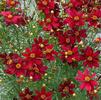
|
Coreopsis verticillata 'Sassy Saffron'Coreopsis, Threadleaf
Cheery yellow flowers with deep maroon, nearly black centers atop classic threadleaf foliage. SIZZLE AND SPICE: compact, rounded habit; early to late summer blooms in bright tones.
[
More Info
]
|

|
Coreopsis verticillata 'Zagreb'Coreopsis, Thread-Leaf
Bright golden yellow flowers on upright compact, vase-shaped plants with airy, fernlike foliage. Long bloom time. Easy to grow. Long lived species of coreopsis. Drought tolerant once established.
[
More Info
]
|

|
Cornus drummondiiDogwood, Rough
[
More Info
]
|

|
Corylus americanaFilbert, American
[
More Info
]
|

|
